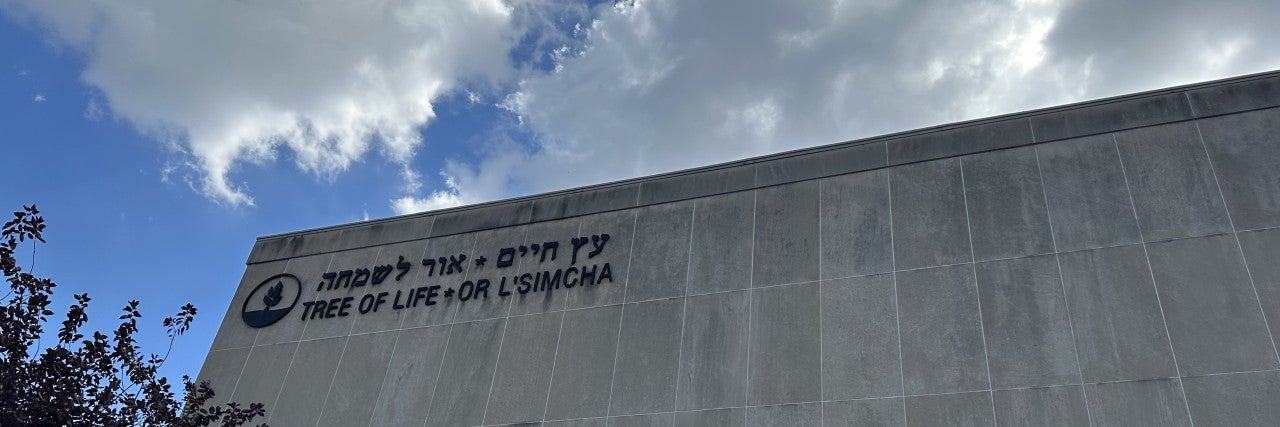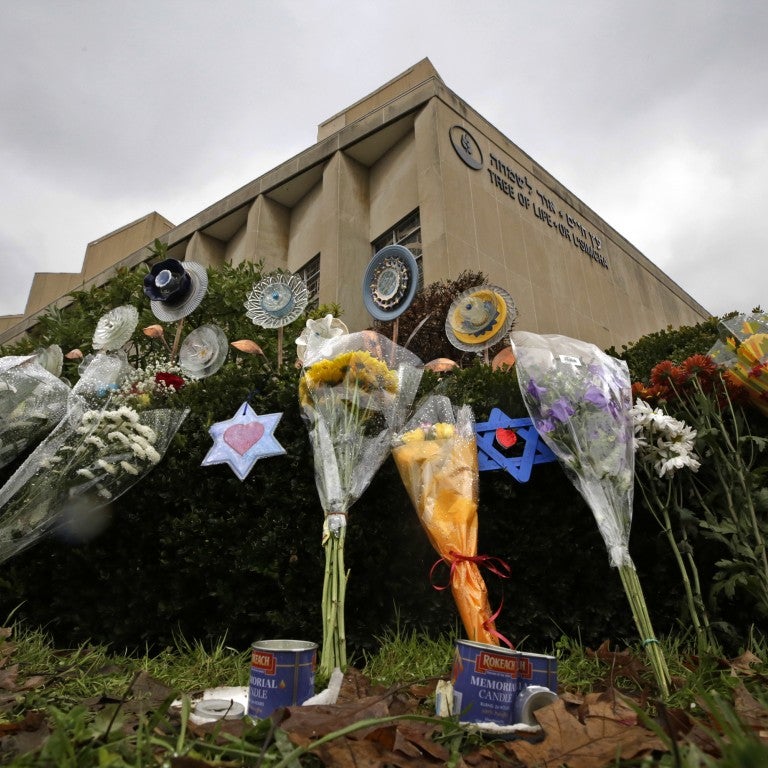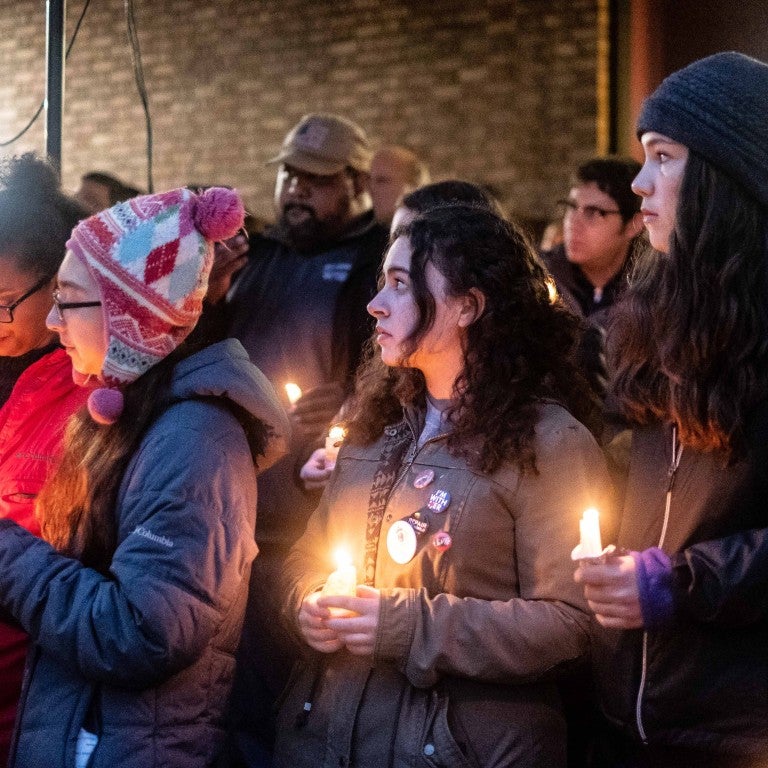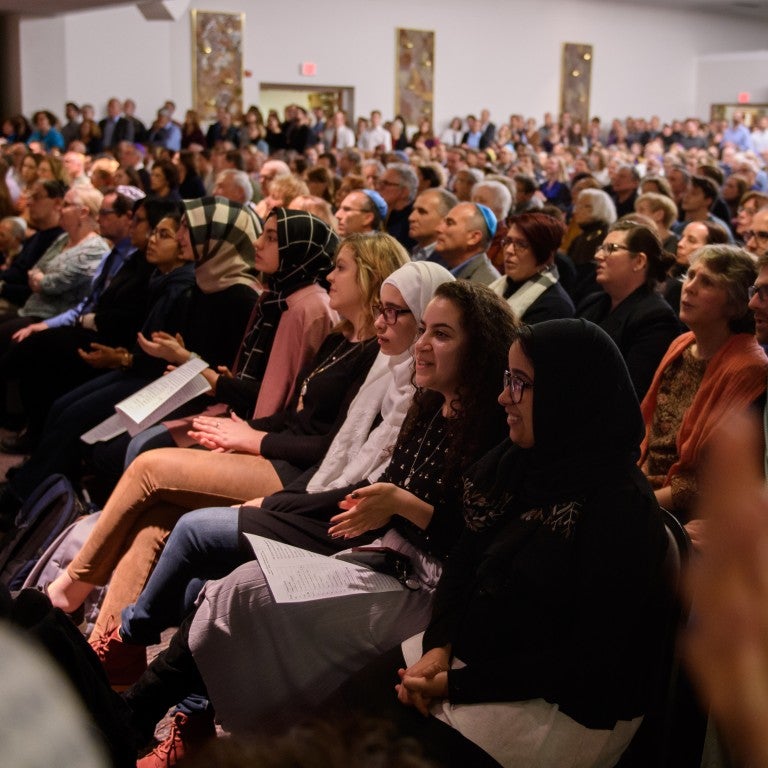October 5, 2023
This month, we mark the five-year anniversary of the Pittsburgh Synagogue Shooting at the Tree of Life. On October 27, 2018, 11 worshipers were murdered solely for being Jewish, in the deadliest antisemitic attack in U.S. history.
As the first installment in a four-part series, we take you inside the Tree of Life building before it is demolished in the coming months to make way for a new complex dedicated to Jewish life and combating antisemitism. Hear from Carole Zawatsky, the CEO behind the reimagined Tree of Life, and Eric Lidji, director of the Rauh Jewish Archive, as they explain their mission: to preserve artifacts and memories so that the story is preserved forever. Carole shares her commitment to honoring the victims, and Eric discusses the challenges of documenting an ongoing tragedy. Together, they emphasize the power of bearing witness to history and the healing strength of remembrance.
*The views and opinions expressed by guests do not necessarily reflect the views or position of AJC.
Episode Lineup:
- (0:40) Eric Lidji, Carole Zawatsky
Show Notes:
Music credits:
- Relent by Kevin MacLeod (incompetech.com), Licensed under Creative Commons: By Attribution 3.0
- Virtual Violin Virtuoso by techtheist is licensed under a Attribution 4.0 International License
- Fire Tree (Violin Version) by Axletree is licensed under a Attribution 4.0 International License.
- Al Kol Eleh (backing track), with Yisrael Lutnick
Take Action:
Follow People of the Pod on your favorite podcast app, and learn more at AJC.org/PeopleofthePod
You can reach us at: peopleofthepod@ajc.org
If you’ve appreciated this episode, please be sure to tell your friends, and rate and review us on Apple Podcasts.
Episode Transcript:
Eric Lidji: Pittsburgh definitely is not forgetting. It’s ever present here. There are people who are healing and doing so in ways that, at least from the outside, are remarkable and very inspiring. And there are people who I'm sure have not fully reckoned with it yet.
Carole Zawatsky: It's all too easy to walk away from what's ugly. And we have to remember. We can't walk away.
Manya Brachear Pashman: Five years have gone by since the horrific Shabbat morning at Pittsburgh’s Tree of Life Synagogue, when eleven congregants were gunned down during prayer – volunteers, scholars, neighbors, doing what they always did: joining their Jewish community at shul.
This is the first installment of a series of episodes throughout the month of October devoted to remembering and honoring the lives lost that day and reflecting on how the deadliest antisemitic attack in American history changed those families, changed us, and changed our country.
Today, we take you to the Tree of Life building that stands on the corner of Shady and Wilkins Avenues in Pittsburgh’s Squirrel Hill neighborhood to hear from two people in charge of preserving the artifacts and memories of the vibrant Jewish life that unfolded inside those walls until October 27, 2018.
In early September, our producer Atara Lakritz and I visited the Tree of Life synagogue in Pittsburgh’s Squirrel Hill neighborhood. Squirrel Hill, where Jews have settled since the 1920s, is quite literally Mister Rogers’ neighborhood. We were there to interview those touched by the events of October 27. But it didn’t take us long to figure out that everyone there had been affected in some way.
All along Murray Avenue, in 61C Cafe, at Pinsker’s Judaica Shoppe, at the Giant Eagle supermarket, when we told people why we were there, they all had a story, an acquaintance, a connection.
Later, walking through the glass doors of the synagogue felt like we were stepping through a portal, traveling back five years, when life stopped, and the reality of the hatred and terror that unfolded there began to haunt every step.
Atara and I were invited to accompany a final group tour of the building before it closed in order for preparations to begin for the building’s demolition. The tour was painful, but we felt it necessary to share with our listeners.
As we left the lobby, we were told to take the stairs to the left. The stairs to the right were off limits. Someone had been shot there.
We were led to a small, dark storage room where chairs had been stacked for guests. A handful of people had hidden there as the shooter continued his rampage, but one man walked out too soon, thinking it was safe. When first responders later came to get the others, they had to step over his body.
In the kitchen, there were still marks on the wall where the bullets ricocheted when he shot two women hiding underneath a metal cabinet. The calendar on the wall there was still turned to October 2018 with a list of activities that were happening that week posted alongside it.
And in the Pervin Chapel where seven people died, pews punctured with bullet holes and carpet squares stained with blood were no longer there. No ark either.
But remarkably, the stained glass windows remained with images and symbols of Jewish contributions to America, the land to which the ancestors of so many worshipers once inside that synagogue had fled to and found safety. Those windows will be carefully removed by the son of the man who first installed them 70 years ago. And they will return, when the reimagined Tree of Life rises again.
Carole Zawatsky: The tragedy is a Pittsburgh experience. But it's also every Jew’s experience. It shattered for so many of us our sense of security in America. This is our safe haven. This is where we came to.
Manya Brachear Pashman: Carole Zawatsky is the inaugural CEO of the reimagined Tree of Life. Since November 2022, she has overseen the development of a new complex on the hallowed ground: an education center dedicated to ending antisemitism, including a new home for the Holocaust Center of Pittsburgh; a memorial to the lives lost that Shabbat morning; a dedicated synagogue space where the Tree of Life congregation can return.
Carole Zawatsky: What can we build to enrich Jewish life, to remember this tragedy, and to show the world that we as Jews should not be known only by our killers and our haters, we should be known by our joy, our celebrations, our rituals, our resilience.
Manya Brachear Pashman: The founding director of the Maltz Museum in northeast Ohio, Carole has spent the last 30 years developing programs and education around the Holocaust and genocide, and overseeing projects that explore Jewish heritage from a national perspective and through a local lens. She led our tour.
On October 27, 2018, the congregations of Tree of Life, New Light, and Dor Hadash, which all met in separate areas of the large, multi-story building, had just ushered in the new Hebrew year of 5779. Young students at the Hebrew school had written their own personal Ten Commandments that the teachers had hung on the walls of an upstairs classroom.
Carole Zawatsky: Don't egg your neighbor's house, respect your parent. Every one of them said: Thou shalt not murder. Thou shalt not kill. And those 10 commandments that they wrote in their little student handwriting were thumbtacked up on the wall in the very classroom where the gunman was apprehended.
Manya Brachear Pashman: Before the rebuilding of Tree of Life begins, Carole’s no. 1 priority has been preserving the artifacts and remnants that bear witness to what happened. Artifacts include the ark, damaged by bullets, the Torah scrolls, which were remarkably unscathed but for the handles. The list of whose Yahrzeits fell on that day, still on the podium; and, of course, the children’s artwork and the wall behind it.
Carole Zawatsky: In the work happening here, and in my role as the CEO, I constantly ask: ‘Am I doing it right? Am I doing enough?’ And preserving the evidentiary material was incredibly important to me, that we have the physical evidence to bear witness. And as that drywall in the classroom in which the gunman, the murderer, was apprehended, was coming down, I found myself asking: ‘Have I saved enough? Will this story be preserved forever? Have we done everything we can?’
Manya Brachear Pashman: Helping Carole with this Herculean effort, is Eric Lidji, the director of the Rauh Jewish Archive at the Senator John Heinz History Center, an affiliate of the Smithsonian Museum, in downtown Pittsburgh. Eric has been collecting documentation and evidence for the archive since October 28, 2018.
Painted stones left in memory of the victims, hand-made signs, pamphlets, and prayers from vigils, sermons from interfaith services. But also a pair of tennis shoes, a guitar, a framed leaf from the Raoul Wallenberg Tree planted in Israel, a cross affixed with Stars of David -- all individual expressions of a community-wide anguish.
Eric Lidji: Even before I entered the building, we knew that there were going to be pieces of the building that had historic value. Since late 2018, I've been in the building numerous times, dozens of times, doing work there. And it sort of culminated in this opportunity in early June, where we were allowed to go in and identify pieces of the building that became historic that day, and figure out how to get them out.
Manya Brachear Pashman: This is no simple job for anyone involved, no less for Eric, who is accustomed to handling archival materials from generations past, not the present.
Eric Lidji: It’s hard for me to disentangle the work of pulling these things out of the building with the knowledge that these families that I've come to know and love, that this is sort of directly related to their loved ones passing.
Pittsburgh definitely is not forgetting, it’s ever present here. There are people who are healing and doing so in ways that, at least from the outside, are remarkable and very inspiring. And there are people who, I'm sure, have not fully reckoned with it yet.
The stories that we're used to telling at the archive, they move much slower. You know, when you get records from 75 or 100 years ago, that's in motion too, but it's moving very slowly. And you can kind of sit there and watch it, and understand it. And get some sense of what it might mean. But when you're living through something, it's changing constantly, all around you. And it's responding to things in the world. And it's responding to people's internal resilience and their ability to grow.
When I look out at the community, I see a lot of different stories. People are in a lot of different places. And it's going to be different on a month like this, where we're saying Yizkor. And it's going to be different in the early stages of the trial versus the late stages of the trial. It's assimilated into our lives now, it's a part of our lives.
Manya Brachear Pashman: In 2019, Eric and journalist Beth Kissileff assembled an anthology of raw reflections by local writers about the Tree of Life massacre. It included only one essay by someone inside the building that day: Beth’s husband, Rabbi Jonathan Perlman of New Light. Eric also contributed his own essay. He wrote: “I have no special insight into why this attack happened, or why it happened here. I don’t know what would have prevented it from happening here or what would prevent it from happening again somewhere else. I don’t understand the depth of my sorrow or the vast sorrow of others.
I asked him if four years later he would still write those words.
Eric Lidji: I feel the same way. You know, there's a second half to that paragraph, which is that, I do have the materials and I can describe those. The premise of an archive is that at some point, we'll all be gone. And when we're all gone, our things are what speak for us. And at the moment, there's a lot of witnesses here, emotional witnesses, I mean, who can testify to what this means.
But there's going to come a time where they won't be there. And our job, I say our, I mean everybody's, our job in the present is to document our experience. So that when we're not here anymore, people in the future have the opportunity to have access to the intensity of the feelings that we had. That ultimately is how you prevent complacency. And so I don't claim any, I don't understand anything in the present. But I do understand the records. And I hope that we're being a good steward and custodian of them so that in the future, people have the opportunity to have access to real human feeling and so that they can really understand what this experience was like for people who were alive today.
Manya Brachear Pashman: The Rauh Jewish Archive has collected and preserved thousands of artifacts and documents, but no physical or intellectual access has been granted yet. Cautious care has been taken to make sure families and survivors are ready and know what’s involved in making the materials available to the public. Once that happens, a trove of electronic materials will be uploaded to the newly launched October 27 Archive, which will become the public face of the collection. The electronic catalog will help individuals, schools, and institutions such as Tree of Life to tell the story they’re trying to tell.
Carole Zawatsky: We're the only generation to bear witness to this. The next generation will not bear witness. Their children will not bear witness. We have a moral obligation to ensure that these lives are remembered and memorialized, and that we as Jews and as citizens of this earth remember what hate looks like and work toward a better world. It's all too easy to walk away from what's ugly. And we have to remember. We can't walk away.
Manya Brachear Pashman: The Tree of Life building is now a shell of what it once was. The stained glass windows will soon be removed for safekeeping until the new building is ready to welcome them back. As the demolition crews arrive to remove what’s left, Carole’s focus has shifted.
Carole Zawatsky: Our focus now is truly on working with our architect, working with the exhibition designer, and forming a new institution. This is an incredibly special moment for us, as we come together and continue to crystallize our mission, our vision, and form this new institution that will be a significant part of the Pittsburgh community, along with the national community.
Manya Brachear Pashman: The architect for the project, Daniel Libeskind, a son of Holocaust survivors who is renowned for his redesign of the new World Trade Center site, has described the spiritual center of the Tree of Life as a Path of Light, which connects and organizes the public, educational, and celebratory spaces.
Carole Zawatsky: We can never as Jews allow ourselves to be defined by our killers. And I'm delighted to be working with Daniel as our architect and his concept of bringing light into the darkness. Vayehi or, let there be light. We have to bring light back to the corner of Shady and Wilkins. And side by side with tragedy, as we have done throughout all of Jewish history, is also celebration. To have baby namings and B’nai Mitzvot. Celebrate Shabbat and celebrate holidays side by side. That this is the most Jewish thing we can do. When the temples were destroyed in Jerusalem, what did we do? We recreate. And that is the strength and resilience of the Jewish people.
Manya Brachear Pashman: Carole also continues to build a multifaith donor base, comprised of foundations and individuals from Pittsburgh and across the country, to raise the $75 million needed to make the reimagination a reality, ideally by 2025. The reasons why donors give vary, but in most cases they’re deeply personal.
Carole Zawatsky: The events of 10/27 are personal for everyone. For those people who tell us: I heard the gunshots from my kitchen. I was with my children. From people across the country who experienced a sense of loss of safety. To non-Jews who say: I have to have something to tell my children why some people don't like their friends. What did I do? How did I help be a part of the solution?
Manya Brachear Pashman: For generations, the Jewish people have confronted antisemitism in its many forms. But through it all, the Jewish calendar continues to guide the community through celebrations of life and beauty and wonder. Carole describes it as the bitter and the sweet.
Carole Zawatsky: I've had on occasion, a Rabbi, a funder: ‘How are you doing? How do you get through this?’ And for me, there's often a soundtrack in my head. And one of my favorite Hebrew songs is “Al Kol Eleh,” and through the bitter and the sweet. To me, it is the definition of Judaism. And it's the definition of what we're doing.
Manya Brachear Pashman: Do you mind sharing a bit of that song with us now?
Carole Zawatsky:
Al hadvash ve'al ha'okets
Al hamar vehamatok
Al biteynu hatinoket shmor eyli hatov
Al kol eleh, al kol eleh.
Manya Brachear Pashman: This podcast is dedicated to the 11 lives lost on October 27, 2018:
Joyce Fienberg,
Richard Gottfried,
Rose Mallinger,
Jerry Rabinowitz,
Cecil Rosenthal,
David Rosenthal,
Bernice Simon,
Sylvan Simon,
Daniel Stein,
Melvin Wax,
Irving Younger.
May their memories be for a blessing.





